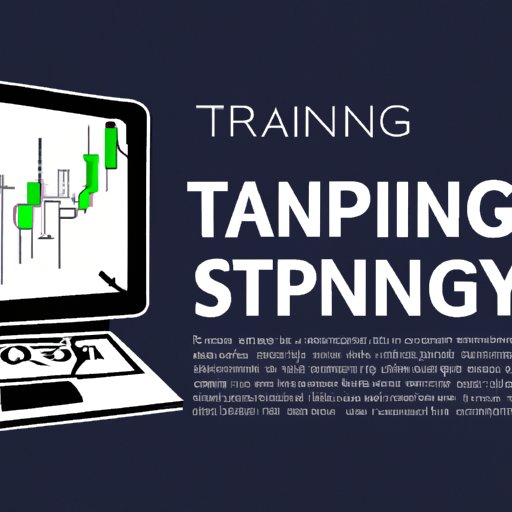Introduction
Trading stocks, commodities, currencies, and other financial instruments can be a profitable endeavor, but only if you know what you are doing. There are many different strategies and methods for trading, and it can be difficult to know which one is the best for you. In this article, we will explore the different ways to trade, from technical analysis and fundamental analysis to options trading strategies, leverage and margin, scalping, and automated trading systems.
Technical Analysis
Technical analysis is a popular method of trading that involves examining price charts to identify patterns and trends. This type of analysis relies heavily on the use of technical indicators, such as moving averages, oscillators, and support and resistance levels. The goal of technical analysis is to identify potential entry and exit points in the market so that traders can capitalize on short-term price movements.
The benefits of technical analysis include the ability to spot potential opportunities quickly and efficiently. However, there are also some challenges associated with this type of trading. For example, technical analysis relies heavily on past performance, which may not always be an accurate indicator of future price movements.
Fundamental Analysis
Fundamental analysis is another popular method of trading that focuses on the underlying fundamentals of a company or security. This type of analysis involves looking at financial statements, such as balance sheets, income statements, and cash flow statements, to gain insight into a company’s performance. By understanding a company’s performance, traders can make informed decisions about whether to buy or sell a particular security.
The benefits of fundamental analysis include the ability to gain an in-depth understanding of a company’s operations and financial position. However, this type of analysis is also time-consuming and may require a significant amount of research. Additionally, it can be difficult to accurately interpret financial statements, which can lead to inaccurate predictions.
Options Trading Strategies
Options trading is a type of trading that allows traders to take advantage of price movements without actually owning the underlying asset. Options trading involves buying and selling options contracts, which give the buyer the right (but not the obligation) to buy or sell an underlying asset at a predetermined price. Options traders can use a variety of strategies to profit from price movements, including long call, short call, long put, and short put.
The benefits of options trading include the ability to leverage capital and limit risk. Additionally, options provide traders with a greater degree of flexibility than traditional trading. However, options trading is complex and requires a significant amount of knowledge and experience in order to be successful.
Leverage and Margin
Leverage and margin are two important concepts in trading. Leverage refers to the use of borrowed money to increase potential returns. Margin refers to the amount of money required to open a leveraged position. Leverage and margin can be used to increase potential profits, but they also increase the risk of losses.
The advantages of leverage and margin include the ability to increase potential returns. However, it is important to understand the risks associated with these strategies and to use appropriate risk management strategies to protect against large losses.
Scalping as a Trading Method
Scalping is a type of trading that involves taking small profits from small price movements over a short period of time. Scalpers look for small changes in the market and attempt to capitalize on them quickly. This type of trading requires a lot of time and effort, as well as a high level of discipline.
The benefits of scalping include the ability to generate quick profits in a short amount of time. However, scalping also carries a high level of risk, as small price movements can quickly turn against the trader. Additionally, scalping requires a great deal of focus and attention, which can be difficult to maintain over a long period of time.
Automated Trading Systems
Automated trading systems, also known as algorithmic trading, are computer programs designed to buy and sell securities based on predetermined rules. These systems can execute trades faster and more accurately than humans, and they can help traders reduce their risk by limiting losses. However, automated trading systems are not perfect, and they can still suffer losses due to unexpected events or market conditions.
The benefits of automated trading systems include the ability to trade faster and more accurately than humans. Additionally, these systems can help traders reduce their risk by limiting losses. However, automated trading systems can also be unreliable and may suffer losses due to unforeseen market conditions.
Conclusion
There are many different ways to trade, and each has its own advantages and disadvantages. Technical analysis and fundamental analysis are popular methods of trading that rely on the analysis of price charts and financial statements, respectively. Options trading strategies provide traders with the ability to leverage capital and limit risk. Leverage and margin can be used to increase potential profits, but they also increase the risk of losses. Scalping is a type of trading that involves taking small profits from small price movements over a short period of time. Finally, automated trading systems can help traders reduce their risk by limiting losses, but they can also be unreliable.
In conclusion, there is no single “best” way to trade. Each method has its own advantages and disadvantages, and traders should choose the one that best suits their needs and goals. It is important to remember to use risk management strategies to protect against large losses, regardless of the trading method used.
(Note: Is this article not meeting your expectations? Do you have knowledge or insights to share? Unlock new opportunities and expand your reach by joining our authors team. Click Registration to join us and share your expertise with our readers.)
